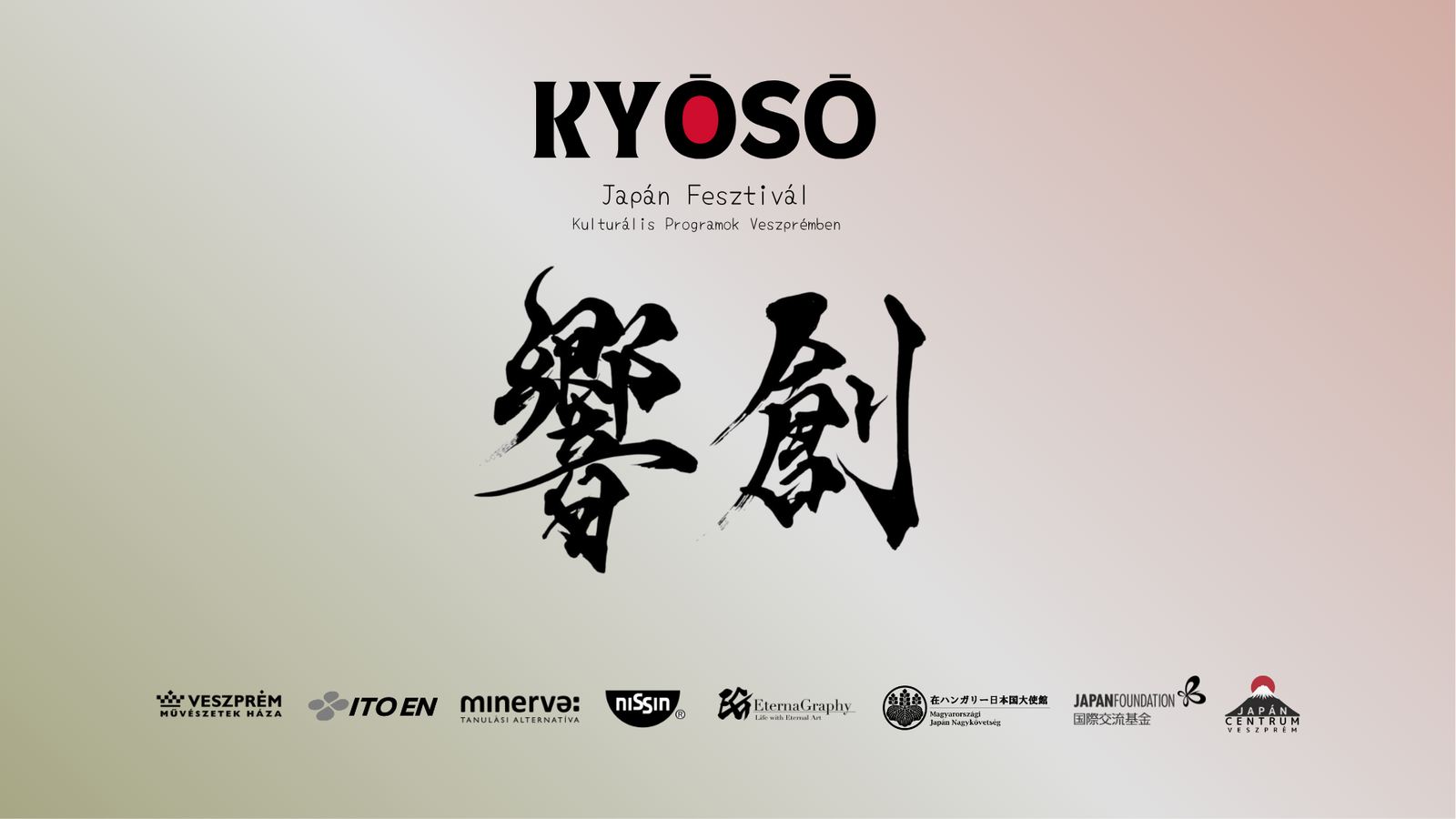KYŌSŌ / Japanese Festival - Cultural Programmes in Veszprém


On the last Saturday of August, the Japan Centre and the House of Arts Veszprém invite visitors to a one-day mini-festival celebrating the fusion of Japanese and Hungarian culture.
The changing of the seasons creates a rhythm, brings variety to our everyday lives, and offers a continuous sense of renewal. This event serves as a preparatory programme element for the upcoming "KYŌSŌ Project" to be launched next year. KYŌ-SŌ means: 響 = sound, echo, resonance; 創 = creation, generation. The aim of the project is to connect Japanese and Hungarian artists through cultural exchange in the fields of music and visual arts. We strive to develop a sustainable model for international cultural collaboration, while also expanding cultural networks to explore new creative opportunities.
Our new programme series is born from the meeting of respect for tradition and contemporary cultural values. In February, April, August and November, we showcase collaborations based on authentic Japanese-Hungarian relations.
The summer thematic day will revolve around topics such as shodō, sumō-e, suminagashi, sashiko, shibori, furoshiki and kōdō. Alongside creative art workshops, the programme will include a Japanese music concert featuring the Okinawan sanshin, a sake lecture and tasting, film screening, kimono exhibition, and fine art and photography displays.
Supported by: Embassy of Japan, Japan Foundation Budapest, Nissin, EternaGraphy, ITO EN Europe, Minerva Alternative Learning Veszprém, Japan Centre Veszprém, Municipality of Veszprém
Japanese Calligraphy
Kazuki Jade Mitsui, a shodō artist, first picked up a brush at the age of six, and by year 8 had attained the highest rank from the Japan Calligraphy Association. He currently runs a design company focused on calligraphy and regularly organises solo exhibitions and events both in Japan and abroad.
Japanese Songs
Singer Nóra Nagy has been studying singing since the age of 12. She achieved first place in jazz, musical, and chanson categories at the University of Szeged’s music competition in November 2024 and May 2025. She speaks fluent Japanese and actively works to build bridges between Japanese and Hungarian culture.
Attila Blaho is a jazz pianist, master instructor at the University of Szeged, performer, and composer. He has performed on jazz singer Veronika Harcsa’s tour in Japan.
Takaki Ando is a sanshin performer who has worked in six countries so far. His mission is to introduce Okinawa’s traditional instrument—the sanshin—to as many people as possible. He also volunteers in local activities as part of this aim.
Kimono Exhibition and Presentation
A selection from Dr. Tímea Kocsis’s kimono collection, gathered over 20 years. The exhibition includes rare pieces, some of which are over 100 years old.
Furoshiki Presentation and Demonstration
Eco-friendly, reusable Japanese and Hungarian-designed cloths used for gift wrapping and bag making, presented by Anna Pápai-Vonderviszt, Japanologist and head of the Furoshiki Section of the Hungary-Japan Friendship Society.
Kōdō
Nihon no Kaori means "the scent of Japan."
Ferenc Dinya has been studying Japanese incense, its rituals, and associated traditions for nearly eight years. The workshop introduces incense made and used in Japan, alongside its customs and ceremonial aspects. Participants will try fermented and powdered incense, as well as valuable resinous wood chips.
Suminagashi
Suminagashi is a traditional Japanese paper marbling technique. It involves floating ink on water and capturing the resulting patterns on rice paper (suminagashi = floating ink). The workshop is led by Szabolcs Mészáros, painter and graduate of the Hungarian University of Fine Arts. In addition to painting, he teaches drawing and art history at the Handler Nándor Technical School in Sopron.
Japanese Bookbinding
Participants will learn a traditional Japanese hand-binding technique known as “stitched books”, historically used to bind manuscripts. The session is led by visual artist Bence Orsós.
Shibori
Shibori is a traditional Japanese fabric dyeing technique dating back to the 8th century. It involves methods such as folding, crumpling, twisting, pressing, tying, and stitching to resist dye and create unique patterns on fabric.
Sashiko
Sashiko is a traditional Japanese hand-stitching technique originally used to reinforce and repair clothing. The repeated, geometric stitch patterns not only made the textile more durable but also gave it a distinctive aesthetic quality. The workshop introduces the basics of this technique and the necessary tools.
Sumō-e
“Sumō” – as a ritual, competitive sport, and form of entertainment – has been an integral part of Japanese life since ancient times. Sumō also appeared in the visual arts, notably in the woodblock print genre known as ukiyo-e in the second half of the 18th century, where popular wrestlers, their matches, and traditional attire were depicted. Today, visual artist Kinoshita Daimon is the only officially recognised sumō painter whose works are created using the same traditional techniques as those from the Edo period (1603–1867), and they continue to enjoy widespread popularity. This exhibition presents works by Master Daimon and his student, Kato Madoka.
Programmes
10:00 – 13:00 Workshops (suminagashi, shibori, sashiko, kōdō, furoshiki, Japanese bookbinding)
Courtyard of the Dubniczay Palace. In case of bad weather: Baroque rooms, 1st floor.
11:00 Opening of the Sumō-e exhibition, S-studio
14:00 – 17:00 Workshops (suminagashi, shibori, sashiko, kōdō, furoshiki, Japanese bookbinding)
Courtyard of the Dubniczay Palace. In case of bad weather: Baroque rooms, 1st floor.
14:00 Exhibition tour by Enikő Czigány – Under the Sky, Above the Earth, Magtár Gallery
14:30 Exhibition tour by Csaba Toroczkai – Colours of Japan, Dubniczay Palace D2
15:00 Kimono exhibition and presentation, Dubniczay Palace, Baroque rooms, 1st floor
16:00 Japanese Songs concert, Dubniczay Palace, Baroque rooms, 1st floor
17:00 Opening of the Shodō (calligraphy) exhibition, Castle Gallery
These programmes are free of charge, and due to limited venue capacity, attendance is on a first-come, first-served basis.
18:00 – 20:00 Sake lecture and tasting, Tegularium
The presentation and tasting are only for people over 18. The ticket costs 5,000 HUF per person. Ticket purchase online from 5 August.
20:00 Film screening: Wim Wenders – Perfect Days (2023), FOTON
Tickets for the screening can be purchased at the Foton Audiovisual Centre.
A borítóképen látható illusztrációt készítette: Kazuki Jade Mitsui
